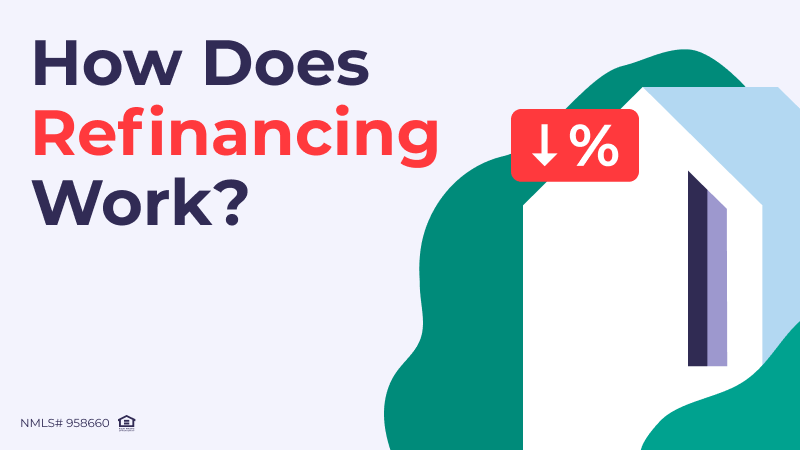CHECK OUT OUR PROGRAMS
In personal finance, understanding how to navigate your client’s mortgage can be a game-changer for their financial health. Refinancing their mortgage is a strategic move that can offer a host of benefits, but it also comes with its set of considerations. This guide aims to demystify the process of mortgage refinancing for your borrowers, making it clear and accessible for homeowners looking to make informed decisions about their home loans.
At its core, refinancing is the process of replacing their existing mortgage with a new loan, typically to take advantage of better interest rates, change their loan term, or access equity in their property. In the current economic climate, refinancing can be especially important as it offers a pathway to reduce monthly payments, tap into home equity for major expenses, or adjust your loan structure to better suit your financial situation.
Understanding the Basics of Mortgage Refinancing
What Does Refinancing Mean?
Refinancing is the act of paying off their current mortgage and creating a new one. This can be with their existing lender or a new one. The main goal is often to lower their interest rate, adjust their mortgage term, access equity, or switch from an adjustable-rate mortgage (ARM) to a fixed-rate mortgage. By refinancing the consumer’s existing loan, the consumer’s total finance charges may be higher over the life of the loan.
Key Types of Refinancing
Struggling with a loan scenario?
Get a solution in 30 minutes!
Fill out the short form and get your personal offer
Submit a Scenario
- Rate-and-Term Refinancing. The most common form, aimed at securing a lower interest rate or changing the loan term without altering the loan amount.
- Cash-Out Refinancing. Involves taking out a loan larger than their current mortgage and pocketing the difference in cash.
- Cash-In Refinancing. They pay down a portion of their mortgage for a lower loan-to-value ratio, a reduced loan term, or a better interest rate.
- Streamline Refinancing. Designed for reducing paperwork and lower costs, available for certain loan types like FHA and VA loans.
Why Consider Refinancing Your Mortgage?
Lowering Your Interest Rate
A primary reason many homeowners refinance is to secure a lower interest rate, which can significantly reduce their monthly mortgage payments and the total interest paid over the life of the loan.
Adjusting Your Loan Term
Refinancing can adjust their loan term to either shorten it, saving on interest over time, or extend it, reducing monthly payments.
Accessing Home Equity
Cash-out refinancing allows your clients to access the equity built up in their home, providing funds for home improvements, debt consolidation, or other significant expenses.
Shifting from ARM to Fixed-Rate
If your borrower initially chose an ARM for its lower rates, refinancing to a fixed-rate mortgage can offer financial stability by locking in a rate for the remainder of their loan term.
Evaluating the Costs and Savings
Breaking Down the Costs
Refinancing involves various costs, including application fees, origination fees, appraisal fees, and closing costs. It’s essential to understand these fees as they can impact the overall savings from refinancing.
Calculating Your Break-Even Point
To determine if refinancing is financially worthwhile, calculate your clients’ break-even point—the time it takes for their monthly savings to exceed the costs of refinancing.
Looking for a suitable loan program?
Choose among 20+ programs and get
a detailed loan calculation
Loan Calculator
Programs
While refinancing can offer immediate monthly savings, it’s crucial to weigh these against the long-term costs and savings, especially if extending their loan term.
The Refinancing Process: Step by Step
Application to Closing Detailed Steps
- Gather Financial Information. Collect all necessary financial documents, including recent pay stubs, tax returns, and information on current debts.
- Shop Around for Lenders. Compare rates and terms from multiple mortgage lenders to find the best deal.
- Apply for Refinancing. Submit their application along with the required documentation.
- Undergo a Home Appraisal. Most lenders require an appraisal to determine their home’s current market value.
- Closing. Once approved, they’ll close on the new loan, which involves signing paperwork and paying any closing costs.
Preparing Your Financial Documents
Having their financial documents in order is crucial for a smooth refinancing process. This includes tax returns, pay stubs, and statements for current loans and debts.
Understanding the Role of Home Appraisal
A home appraisal assesses the current value of their property, which lenders use to determine the maximum loan amount they will offer for refinancing.
Closing the New Loan
Closing involves reviewing and signing the new loan agreement, paying closing costs, and officially starting their new mortgage terms.
4 Key Considerations Before You Refinance
- Financial Goals. Clarify their objectives for refinancing, such as lowering monthly payments or changing your loan term.
- Market Conditions. Interest rates and market trends can significantly affect the benefits of refinancing.
- Your Credit Score. A higher credit score can secure better refinancing terms, so consider your credit health before applying.
- Future Plans Regarding the Home. If they plan to move soon, the costs of refinancing may not be recouped through monthly savings.
Refinancing FAQs
What money does a client get back when they refinance their home?
When your client refinances their home, especially through a cash-out refinance, they can receive money back. This process involves taking out a new mortgage larger than the existing one and receiving the difference in cash. The amount they get back depends on the equity they’ve built in your home and the terms of your new mortgage. It’s essential to remember that this increases your loan amount and potentially your debt.
What happens during a refinance of a home?
During a home refinance, their current mortgage is replaced with a new one, potentially with different terms. This process involves applying for a new loan, undergoing a credit check, and a home appraisal to assess the property’s current value. If approved, they’ll close the new loan, which pays off the existing mortgage. The goal is often to lower interest rates, reduce monthly payments, change the loan term, or tap into home equity.
Is it good to refinance home?
Refinancing can be beneficial if it aligns with their financial goals, such as reducing their interest rate, lowering monthly payments, changing the term of their loan, or accessing equity. However, it’s crucial to consider the costs associated with refinancing, including closing costs and fees, and whether they plan to stay in their home long enough to recoup those expenses through savings.
How does loan refinancing work?
Refinancing a loan involves taking out a new loan to pay off an existing one. This can apply to mortgages, car loans, or student loans. The process includes applying for a new loan with potentially better terms—such as a lower interest rate or different repayment term—and using the funds from the new loan to pay off the old one. This can lead to lower monthly payments, reduced interest costs, or a quicker loan payoff.
Do borrowers lose equity when they refinance?
In a standard rate-and-term refinance, they do not lose equity in their home. However, in a cash-out refinance, where they borrow more than they owe on their current mortgage and receive the difference in cash, they are using a portion of their home’s equity, which reduces the overall equity you have in your property.
Is it risky to refinance?
Refinancing carries risks, including extending the length of their loan, incurring closing costs and fees, and potentially increasing the total interest paid over the life of the loan if they extend their repayment term. It’s also possible to end up with a higher interest rate if market conditions change or if their credit score has decreased since their original loan. Careful consideration of these factors is essential.
Do borrowers need an appraisal to refinance?
Most lenders require an appraisal to refinance a mortgage. The appraisal assesses the current market value of their home, which lenders use to determine how much they are willing to lend and at what terms. The loan-to-value ratio, calculated from the appraisal, is a critical factor in the approval process and the interest rate offered.
How many times can a client refinance their home?
There’s no legal limit to how many times they can refinance your home. However, lenders may have specific guidelines or waiting periods between refinances. It’s essential to consider the costs associated with refinancing, such as closing costs and the potential impact on their financial goals, to determine whether refinancing multiple times is beneficial.
Navigating Refinance Options and Offers
How to Compare Lenders
Looking for a suitable loan program?
Choose among 20+ programs and get
a detailed loan calculation
Loan Calculator
Programs
Look at interest rates, fees, and terms offered by various lenders to ensure they’re getting the best deal for their refinancing needs.
Finding the Best Refinance Rates
Shopping around and comparing offers from multiple lenders can help them find the best refinance rates. Consider online lenders, banks, and credit unions.
Pros and Cons of Refinancing
Pros
- Lower interest rates can reduce monthly payments.
- Access to home equity for large expenses.
- Ability to switch loan types or adjust loan terms.
Cons
- Closing costs and fees may offset savings.
- Extending your loan term can mean more interest paid over time.
- Risk of foreclosure if they cannot keep up with new loan payments.
Making the Decision: Is Refinancing Right for Them?
Personal Financial Assessment
Evaluate their financial situation, including their current mortgage, home equity, credit score, and financial goals, to determine if refinancing makes sense for them.
When to Speak with a Financial Advisor
If they’re unsure about the best course of action, consulting with a financial advisor can provide personalized advice based on their financial situation and goals.
Conclusion
Refinancing their mortgage can be a powerful tool in managing their personal finances, but it’s not a one-size-fits-all solution. By understanding the basics, evaluating the costs and benefits, and carefully considering your financial situation and goals, they can make an informed decision that supports their long-term financial health.
CHECK OUT OUR PROGRAMS
Additional Resources
Here are some useful online calculators and rate comparison tools for mortgage refinancing:
- Fannie Mae Mortgage Refinance Calculator. Provides a straightforward way to calculate potential annual savings and estimated closing costs for refinancing your mortgage. Visit Fannie Mae
- net Refinance Calculator. Offers a tool to plan the refinancing of a loan given various situations, allowing side-by-side comparison of the existing or refinanced loan. Visit Calculator.net
- NerdWallet Mortgage Refinance Calculator. Helps you determine if refinancing is right for you by showing how refinancing will affect your monthly mortgage payment and your total savings. Visit NerdWallet
- Zillow Refinance Calculator. A free tool that evaluates the benefits of refinancing to help meet your financial goals, such as lowering monthly payments or changing the length of your loan. Visit Zillow
- Loan Comparison Calculator – NerdWallet. This calculator helps compare the monthly and total cost of two mortgage, small business, or personal loan offers, assisting in decision-making. Visit Loan Comparison Calculator – NerdWallet
- MortgageCalculator.org. Offers a variety of calculators for refinancing, loan comparison, and evaluating current mortgage loan refinancing rates. Visit MortgageCalculator.org




